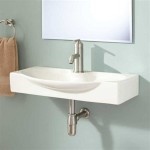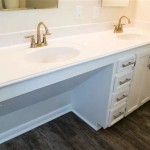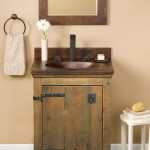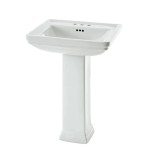Trough Bathroom Sink With Two Faucets Vanity Units: A Comprehensive Guide
Trough bathroom sink vanity units, particularly those equipped with two faucets, have gained significant popularity in contemporary bathroom design. This configuration offers a blend of stylistic appeal and practical functionality, catering to the needs of modern households. This article provides a detailed exploration of trough bathroom sinks with two faucets vanity units, covering their design considerations, material options, installation specifics, maintenance requirements, and various applications.
Design and Aesthetics
The design of a trough bathroom sink vanity unit is characterized by its elongated, basin-like shape. This contrasts with traditional individual sink designs, offering a more continuous and unified appearance. The presence of two faucets enhances both the aesthetic symmetry and practical usability of the fixture.
Material choices significantly influence the overall aesthetic. Popular materials include:
- Ceramic: A classic choice known for its durability, ease of cleaning, and availability in various colors and glazes. Ceramic provides a timeless look suitable for diverse bathroom styles.
- Stone (Marble, Granite, Quartz): These materials offer a luxurious and sophisticated appearance. Natural stone provides unique veining and patterns, while engineered quartz offers consistent color and enhanced durability.
- Concrete: Concrete sinks offer a modern, industrial aesthetic. They can be customized with various pigments and finishes, providing a distinctive look.
- Stainless Steel: Stainless steel sinks provide a sleek and contemporary look, known for their durability and resistance to corrosion. They are commonly used in minimalist and commercial settings.
Vanity units supporting the sink are typically constructed from wood, MDF (Medium-Density Fiberboard), or metal. Wood vanities offer a warm and traditional feel, while MDF provides a cost-effective and moisture-resistant option. Metal vanities offer a modern and durable choice.
The placement of faucets is also a key design element. Faucets can be mounted directly on the sink deck, on the wall above the sink, or on the vanity countertop. Wall-mounted faucets create a clean and minimalist look, while deck-mounted faucets offer ease of installation and maintenance.
Functionality and Practicality
The primary advantage of a trough bathroom sink with two faucets is its enhanced functionality. The dual-faucet configuration allows two individuals to use the sink simultaneously, reducing congestion and improving efficiency, especially in shared bathrooms. This is particularly beneficial in family bathrooms or master bathrooms shared by couples.
The elongated basin design provides ample space for washing and grooming. The larger surface area helps to contain water splashes and spills, minimizing cleanup efforts. Some trough sinks are designed with a slight slope towards the drain, facilitating efficient water drainage.
Vanity units provide valuable storage space for bathroom essentials. Cabinets, drawers, and open shelves can be incorporated into the vanity design to accommodate toiletries, towels, and other items. Optimizing storage space helps to maintain a clutter-free and organized bathroom environment.
The height of the vanity unit is another important consideration. Standard vanity heights typically range from 30 to 36 inches. Choosing the appropriate height ensures comfortable use for all users, reducing strain and discomfort.
Installation Considerations
Installing a trough bathroom sink with two faucets vanity unit requires careful planning and execution. Prior to installation, it is essential to ensure that the plumbing connections are properly located and compatible with the sink and faucet configuration.
The weight of the sink and vanity unit must be considered when selecting mounting hardware and support structures. Wall-mounted vanities require sturdy brackets and anchors to ensure stability and prevent sagging. Floor-mounted vanities should be leveled properly to ensure even weight distribution.
Plumbing connections for the hot and cold water supply lines must be securely attached to the faucets. Flexible supply lines are recommended for ease of installation and to accommodate minor adjustments. The drain assembly must be properly sealed to prevent leaks. Plumber's putty or silicone caulk can be used to create a watertight seal between the drain flange and the sink basin.
When installing two faucets, it is crucial to ensure that both faucets are properly aligned and spaced apart for comfortable use. Measure the distance between the faucet handles and the center of the sink to ensure adequate clearance. The faucet spouts should be positioned to direct water flow towards the drain and prevent splashing.
It's often recommended to hire a qualified plumber for the installation of a trough bathroom sink with dual faucets. Complex plumbing requirements and the potential for leaks or water damage necessitate professional expertise to ensure a proper and safe installation.
Maintenance and Care
Maintaining a trough bathroom sink with two faucets vanity unit involves regular cleaning and preventative measures to ensure its longevity and aesthetic appeal. The cleaning regimen varies depending on the materials used in the sink and vanity construction.
Ceramic sinks can be cleaned with mild soap and water or specialized ceramic cleaners. Abrasive cleaners should be avoided, as they can scratch the surface and dull the finish. Stone sinks require gentle cleaning with pH-neutral cleaners to prevent staining or etching. Concrete sinks should be sealed periodically to protect against water damage and staining. Stainless steel sinks can be cleaned with stainless steel cleaners to remove fingerprints and water spots.
The faucets should be cleaned regularly to remove mineral deposits and water stains. A soft cloth dampened with vinegar or lemon juice can be used to loosen mineral buildup. Avoid using abrasive cleaners or scouring pads, as they can damage the faucet finish.
The vanity unit should be kept dry and free from moisture to prevent warping or damage. Wipe up spills promptly and ensure proper ventilation in the bathroom to reduce humidity levels. Wood vanities can be treated with wood polish or sealant to protect against moisture and scratches.
Inspect the plumbing connections periodically for leaks or signs of corrosion. Tighten any loose connections and replace worn-out seals or gaskets. Addressing plumbing issues promptly can prevent water damage and costly repairs.
Applications and Suitability
Trough bathroom sinks with two faucets vanity units are suitable for a wide range of bathroom applications, from residential homes to commercial spaces. Their versatility and functionality make them a popular choice for various settings.
In residential bathrooms, trough sinks are commonly used in master bathrooms, family bathrooms, and guest bathrooms. Their ability to accommodate multiple users simultaneously makes them ideal for shared bathrooms. The ample counter space and storage provided by the vanity unit can help to keep the bathroom organized and clutter-free.
In commercial spaces, trough sinks are often found in public restrooms, hotels, and restaurants. Their durability and ease of maintenance make them well-suited for high-traffic environments. The dual-faucet configuration allows for efficient use of the sink, reducing wait times and improving hygiene.
Trough sinks are also used in specialized settings, such as dental offices, medical clinics, and laboratories. Their large basin size and dual-faucet functionality make them suitable for tasks that require ample water and workspace.
The versatility of trough sinks extends to their compatibility with various bathroom styles. They can be incorporated into traditional, modern, contemporary, or minimalist designs. The choice of materials, finishes, and faucet styles allows for customization to match the overall aesthetic of the bathroom.
Types of Trough Sink Vanity Units
Several variations of trough sink vanity units with two faucets exist, each offering distinct features and benefits.
Wall-Mounted Trough Sink Vanity Units: These units are mounted directly to the wall, creating a floating effect. This design enhances the sense of space and simplifies floor cleaning. Wall-mounted units typically require strong wall support to bear the weight of the sink and vanity.
Floor-Mounted Trough Sink Vanity Units: These units rest directly on the floor, providing stability and ample storage space. Floor-mounted units are available in various styles, including cabinet-style vanities, open-shelf vanities, and combination vanities.
Integrated Trough Sink Vanity Units: These units feature a seamless integration of the sink and countertop. The sink is molded directly into the countertop, creating a smooth and cohesive surface. Integrated units are easy to clean and maintain.
Semi-Recessed Trough Sink Vanity Units: These units feature a sink that is partially recessed into the countertop. The sink extends slightly beyond the edge of the countertop, creating a unique visual effect. Semi-recessed units offer a balance between functionality and aesthetics.
The choice of trough sink vanity unit depends on the available space, budget, and personal preferences. Each type offers unique advantages and can be customized to suit the specific needs of the bathroom.

Nice Trough Bathroom Sink With Two Faucets Small Undermount Modern

47 Inch Wall Mount Double Sink Stone Resin Glossy White Trough Bathroom With Two Faucet Hole Small Sinks

There Is A Rectangular Trough In The Bathroom Sink Design Unique Sinks Double

Trough Bathroom Sink With Two Faucets

36 Rectangular Copper Trough Bathroom Sink In Aged Vanity

Artificial Stone Trough Sink Two Faucets Solid Surface Wash Basin Cabinet Basins China Bathroom Made In Com

Boulder Trough Sink Design Bathroom

Double Trough Sink Base By Betonas Bathroom

A New Craze In Bathroom Decoration Trough Sinks
Madeli Xtu1845 60 200 Wh At Decorative Plumbing Supply Showroom Serving The San Carlos Area
Related Posts







